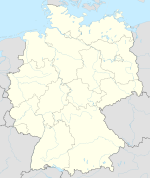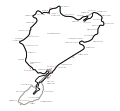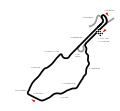Südschleife

Address: |
|
|
|
|
||
| Route type: | permanent race track | |
|---|---|---|
| Owner: | State of Rhineland-Palatinate and the district of Ahrweiler | |
| Architect: | Gustav Eichler, Ravensburg | |
| Start of building: | July 1, 1925 | |
| Opening: | June 27, 1927 | |
| Decommissioned: | 1974 | |
| Demolition: | 1982 | |
| Nürburgring Südschleife | ||
| Route data | ||
| Route length: | 7.747 km (4.81 mi ) | |
| Records | ||
| Track record: (automobile) |
2: 38.6 min. (Helmut Kelleners, March 707, 1970) |
|
| http://www.nuerburgring.de/ | ||
Coordinates: 50 ° 19 ′ 14.1 ″ N , 6 ° 55 ′ 13.2 ″ E
The Südschleife was a 7.747 kilometer long section of the Nürburgring race track in the Eifel . It was built together with the Nordschleife between 1925 and 1927.
The route led south of the start and finish through the Eifel forest in the Müllenbach district , with a gradient of up to 11% and gradients of up to 16%. The difference in altitude was 143 meters. The roadway was 8 meters wide along the route and 20 meters in the start and finish area.
Südschleife as a route variant of the Nürburgring until 1982
The start and finish straight and the back straight of the Nürburgring were part of the start and finish loop , the so-called concrete loop , until 1982 . With it, the south or north loop were combined to form the actual race track, depending on the event. A total of four route variants were possible at the Nürburgring, using the same start and finish system, the same pits and the same connection to the paddock:
- Concrete Loop (2.292 km)
- Südschleife in combination with a concrete loop (7.747 km)
- Nordschleife in combination with a concrete loop (22.835 km)
- Complete course: Combination concrete loop / Südschleife / Nordschleife (28.265 km)
In a race that was held on the Südschleife (in combination with the concrete loop), the vehicles turned left about 550 meters after the start in the direction of Bränkekopf . After a further 5.6 kilometers, they had completely driven through the Südschleife and reached the back straight behind the pits. From there it went to the north bend of the concrete loop, which led back to the start and finish. For smaller events or test drives that did not need the start and finish system, the south loop could also be used independently of the concrete loop thanks to a cross connection. For example, before the 1000 km race at the Nürburgring in 1969, Alfa Romeo ( Tipo 33 ) and Porsche matched their sports prototypes on this variant. Even BMW used this route variant for suspension tuning their Formula 2 .
In races for which the Südschleife was connected to the Nordschleife to form the overall course, the vehicles coming out of the Südschleife turned left towards Hatzenbach at the end of the back straight - as in the races on the Nordschleife.
Use of the Südschleife until 1968
The possibility of combining the south and north loops, as in the opening race on June 18, 1927, to form a 28.265-kilometer overall course, was no longer used after 1931. After that, there were mainly motorcycle races on the Südschleife . From 1928 to 1931 and from 1958 to 1968 the Eifel race for motorcycles and cars also took place there.
On July 31, 1960, the Südschleife was the scene of the German Grand Prix for Formula 2 cars, which was not part of the drivers' world championship and won by Joakim Bonnier ahead of Wolfgang Graf Berghe von Trips , both in a Porsche 718/2 . In 1965 and 1968 the German Grand Prix for motorcycles was held on the Südschleife as part of the motorcycle world championship .
Lap record 1970
The lap record on the Südschleife is held by Helmut Kelleners with 2: 38.6 minutes = 175.85 km / h, driven with a March 707 in the CanAm run of the 3rd International AvD SCM circuit race on October 18, 1970. The previous record holder was Brian Redman , who achieved a Ferrari 2: 47.0 minutes = 161.03 km / h in the Formula 2 race on April 21, 1968.
Route sections
| km | Route section |
|---|---|
| 0 | Start and finish |
| Start and finish straight | |
| Connection to the south bend | |
| 1 | |
| Bränkekopf | |
| 2 | Ashfall |
| Soaps | |
| 3 | |
| Bocksberg | |
| 4th | Müllenbach |
| Rassrück | |
| 5 | |
| Sharp head | |
| 6th | |
| Back straight | |
| 7th | |
| North turn | |
| 7.747 | Start and finish |
The route sections carried u. a. the names Bränkekopf , ash blow , Seifgen , Bocksberg , Müllenbach and Sharp head .
The start-and-finish loop with the south and north bends
Modifications of the Nürburgring
The Südschleife was not included in the renovation work on the Nordschleife in 1970/71. Thus the safety standard of the Südschleife was lower and from the mid-1970s there were no more circuit races there.
Instead, there were several hill climbs starting in Müllenbach, the lowest point on the route. Contrary to the usual direction, we drove up towards the start and finish of the concrete loop. Since the vehicles were returned to Müllenbach via the still existing circuit of the Südschleife, uninterrupted racing was possible. Such mountain races could be carried out within one day with all training and valuation runs.
In the course of the construction of the new Grand Prix track at the Nürburgring in 1983 and 1984, the Südschleife was given up.
Further use

The southwest part of the south loop is now part of the public district road K72. The northern part forms access roads to the parking lots in the southern area of the Grand Prix track. The former section on Bocksberg was almost completely demolished. The safety path that runs parallel to it now leads through an industrial park in Müllenbach, where it bears the name Südschleife as the official street name.
Every year, special stages of the Cologne-Ahrweiler rally lead over the remains of the southern loop. In addition, the Düsseldorf Automobile and Motorsport Club 05 (DAMC 05) showed historic vehicles on the former race track during its classic car festival .
Web links
- Detailed report
- Pictures and driving film
- Map / aerial photo of the Südschleife
- Satellite image of the north and south loop
- Measuring table sheet of the Südschleife from 1935 ( Deutsche Fotothek )
Individual evidence
- ^ Program booklet for the ADAC 1000 km race 1962, p. 37.
- ↑ Michael Behrndt, Jörg-Thomas Födisch, Matthias Behrndt, ADAC 1000 km race , Heel-Verlag, Königswinter 2008, ISBN 978-3-89880-903-0 , p. 248.
- ↑ http://www.pro-teileabschnitt.de/suedschleife/nuerburgring_suedschleife_1965_1974.php Eifelrennen 1969
- ↑ Jörg-Thomas Födisch, Nürburgring , Verlag Pabel / Moewig, Rastatt 1991, ISBN 3-8118-3065-1 , p. 9 and p. 16.
- ↑ a b Behrndt / Födisch / Behrndt: ADAC Eifelrennen. Heel Verlag, Königswinter 2009, ISBN 978-3-86852-070-5 .
- ↑ Födisch / Neßhöfer / Behrndt / Rossbach: Porsche 718 + 804th Verlag Reinhard Klein, Cologne 2009, ISBN 978-3-927458-43-7 .
- ^ Website "Pro Steilstrecke" ( Memento from February 10, 2005 in the Internet Archive )







